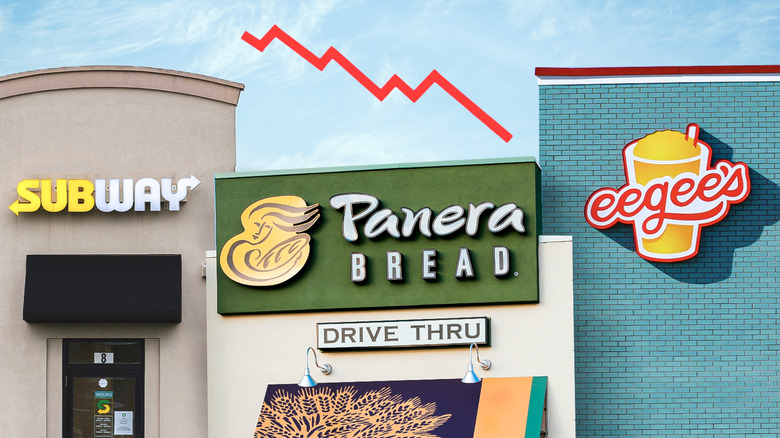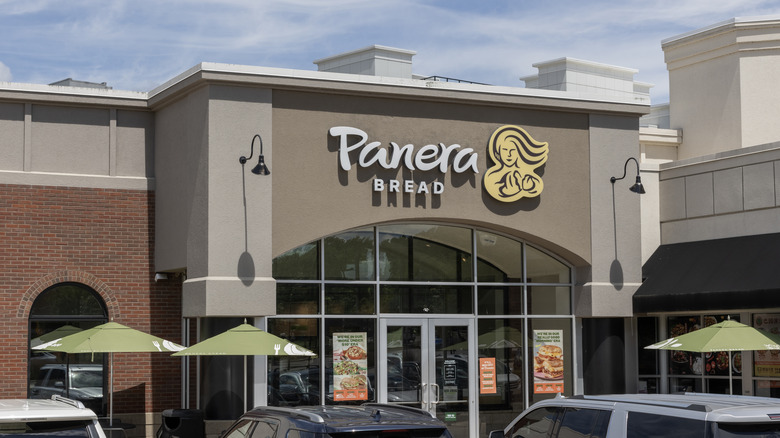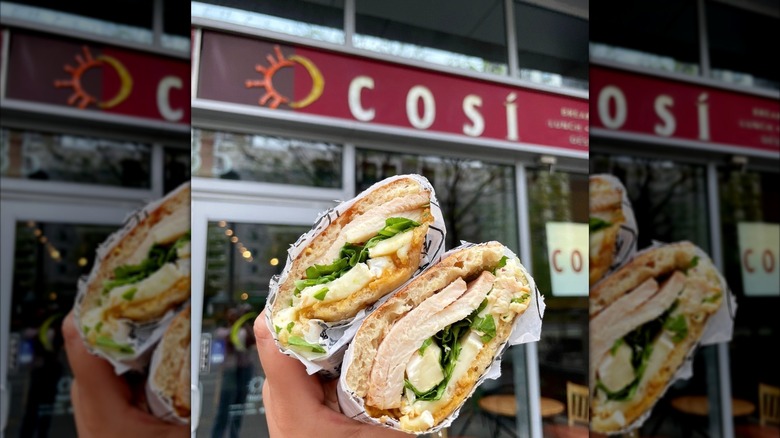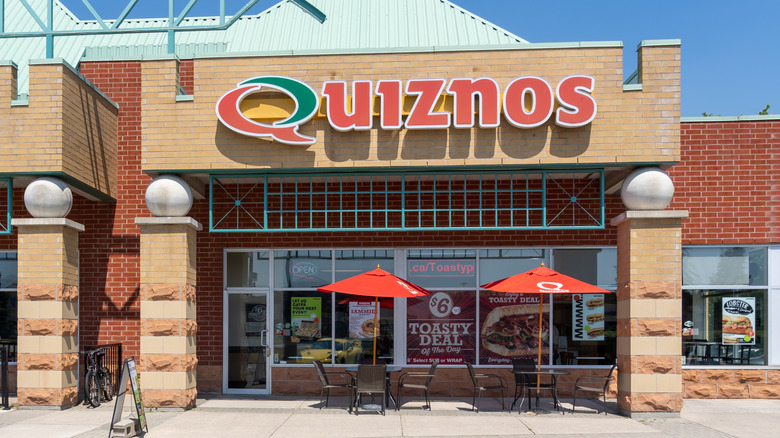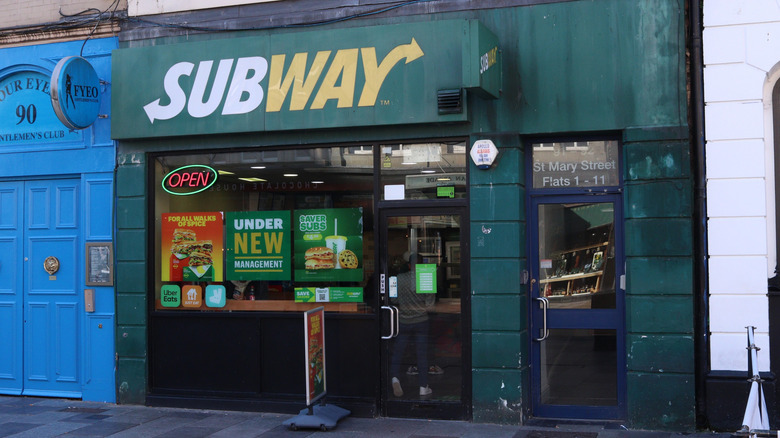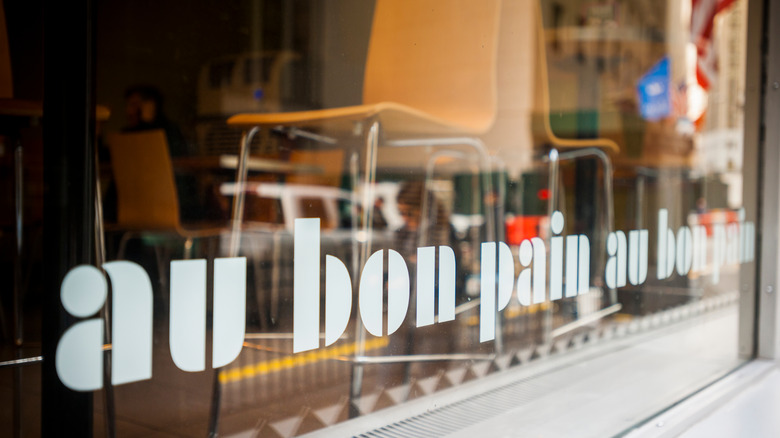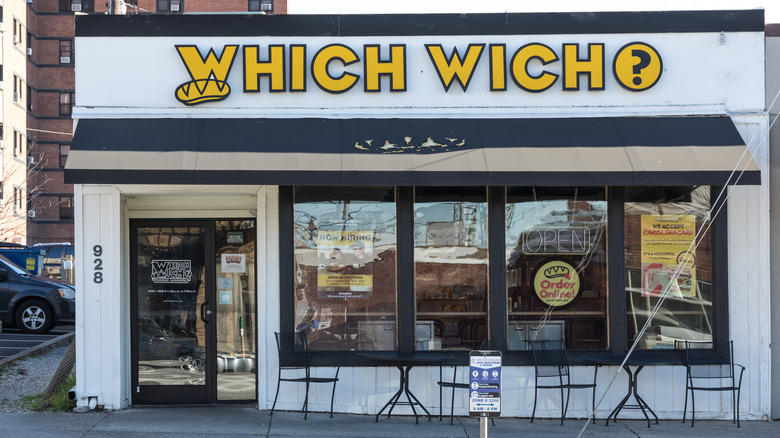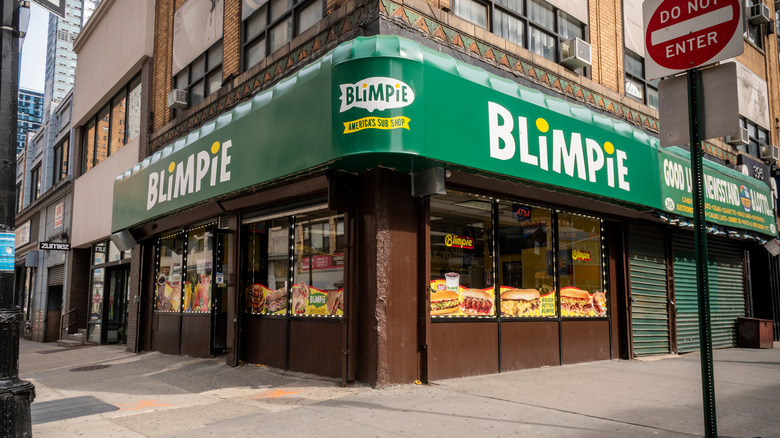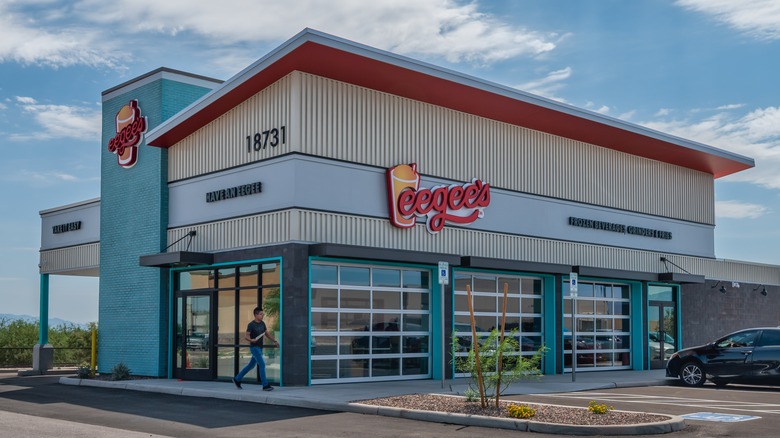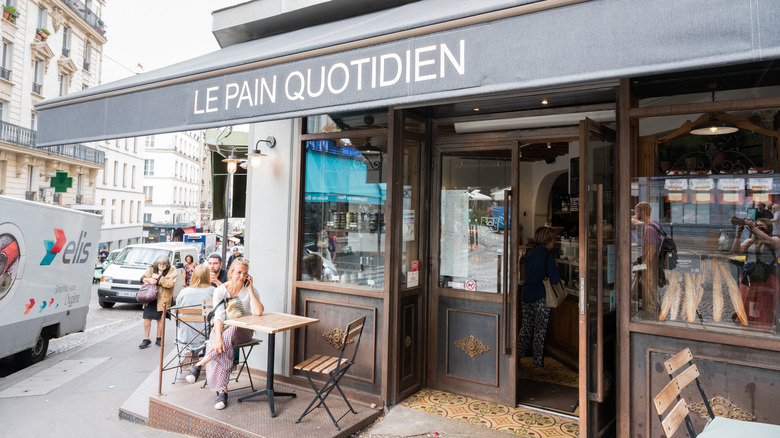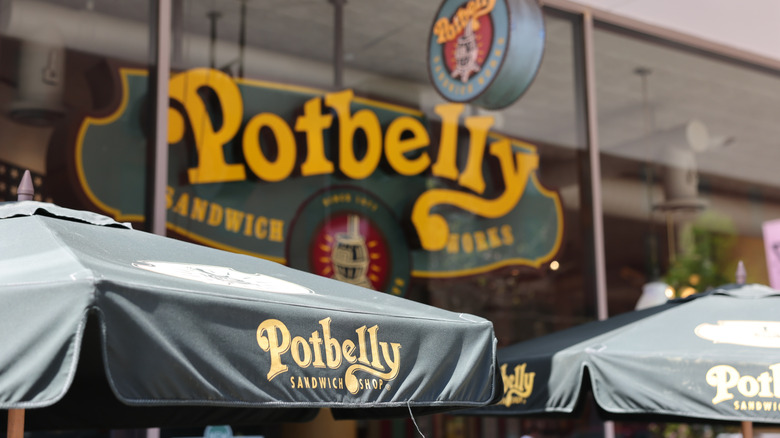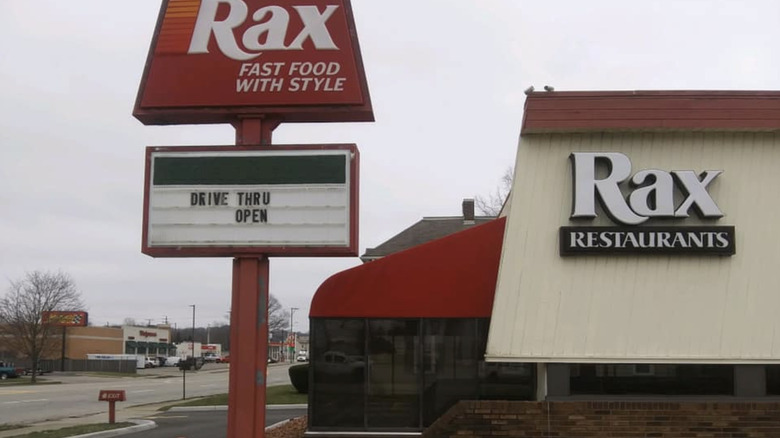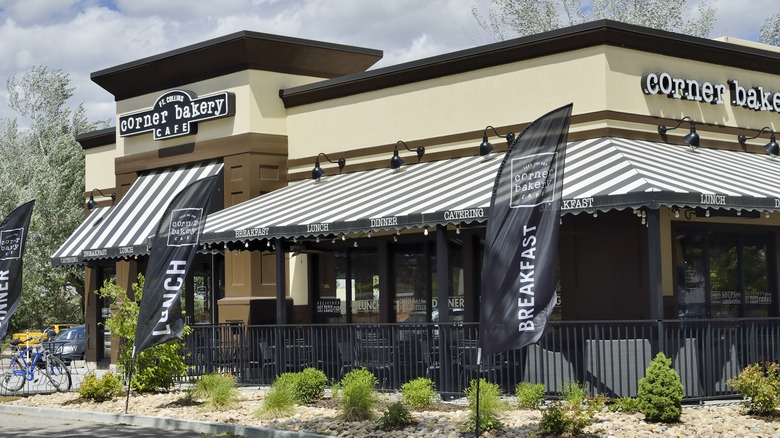Sandwich Chains That Are Struggling To Keep Stores Open
Simple in concept and highly versatile, sandwiches have become a cornerstone of modern eating habits. They are easy to throw together, requiring only bread, filling, and a little imagination. From a basic ham and cheese to heartier creations like pulled pork grilled cheese sandwiches, handhelds prove that simplicity doesn't have to be flavorless and boring.
Given their popularity, it's not surprising that entire chains have built their menus around sandwiches. And while some sandwich shops have chosen to experiment with other menu items, others have kept sandwiches at the forefront of their culinary identity. Despite strong beginnings, not all sandwich chains have managed to sustain long-term viability. Successful for a time, many eventually faced closures due to shifting consumer preferences, rising competition, increasing overheads, and reduced foot traffic brought on by the COVID-19 pandemic.
Regardless of how unexpected it may seem, some well-known — and some lesser-known — sandwich chains are finding it hard to keep their doors open. Ready to find out more? Let's take a closer look at how these once-thriving sandwich shops ended up struggling.
Panera Bread
Panera Bread is a bakery-cafe chain known for serving freshly baked goods alongside sandwiches, soups, salads, and other light meals. The venture started out as St. Louis Bread Company in 1987 with a special sourdough starter from San Francisco — a culture that the company continues to use to this day. Although Panera has gradually expanded in the years since, 2024 saw the chain launch its biggest menu makeover ever, a sign that things may not be totally stable behind the scenes.
Amid this overhaul, Panera has also started closing its fresh dough facilities in a move away from baking its own bread, a practice that has been central to the business since day one. Instead, the chain is moving toward a par-baked bread model to streamline its operations, in which products are half-baked and frozen by third-party contractors, then finished at Panera locations. It expects to close all of its fresh dough facilities between 2025 and 2027. Also worth mentioning is the closure of several underperforming franchise locations around the country.
Così
Founded in Paris, France, in 1989, Così made its American debut in New York City in 1996. The chain's claim to fame is its delicious flatbread, which is made according to a generations-old recipe in an open-flame stone-hearth oven. In 1999, Così merged with Xando, a coffeehouse and bar concept, to broaden its appeal beyond lunch. While Così once operated more than 100 locations in 16 states, as well as Washington, D.C., Costa Rica, and the United Arab Emirates, this number has been gradually shrinking. Today, Così is down to just 14 locations in the U.S.
Over the years, Così has filed for bankruptcy not once, but twice. In 2016, the chain entered bankruptcy proceedings for the first time, closing 29 company-operated locations in an attempt to restructure. One of the chain's central problems was overexpansion, which resulted in multiple underperforming restaurants. Così filed for bankruptcy protection once again in early 2020, declaring a shift from the traditional restaurant model to catering. At the time, the company decided to cut its losses and switched from a sandwich shop to a catering model.
Quiznos
Known for its line of toasted subs, Quiznos used to be hugely popular. In fact, at its peak in the 2000s, the chain had 4,700 locations in the U.S. By 2017, this number stood at fewer than 400. By the end of 2024, Quiznos operated just 148 locations in the U.S., a vast decline from its heyday. Quiznos' early growth was fueled by its signature toasted subs, which set it apart from chains like Subway, which only sold cold sandwiches at the time. So, what caused Quiznos to implode?
Sometimes referred to as one of the biggest restaurant chain failures in history, Quiznos has taken many wrong turns since the restaurant first opened in 1981 in Denver, Colorado. While at one point, Quiznos looked like a rising competitor to Subway, the chain was built on a fragile business model of high supply costs, which ultimately resulted in franchisee unrest. By 2007, Quiznos was being sued by franchisees, some of whom even formed their own associations.
In 2006, private‐equity firm CCMP Capital Advisors bought a stake in Quiznos, with the leveraged buyout leaving Quiznos hundreds of millions of dollars in debt. The recession of 2008 also hit the chain hard, forcing the company and its franchisees to shutter 700 locations in 2009 and 800 in 2010. When the sub venture filed for bankruptcy in 2014, it carried a whopping $875 million in loan obligations.
Subway
It may be hard to imagine that Subway is struggling. Subway is the largest restaurant chain in the country, surpassing even Starbucks and McDonald's in the number of outlets. In reality, the number of Subway restaurants has been decreasing in recent years. While the fast food restaurant peaked with around 27,000 locations in 2015, it has been steadily closing its U.S. locations, with 631 restaurants shuttered in 2024 alone. In May 2025, it was reported that these closures had brought Subway below 20,000 domestic restaurants for the first time in 20 years.
Established in 1965 as Pete's Super Submarines, Subway stayed under family ownership until its $9.6 billion sale to private equity firm Roark Capital in 2023. The chain has also seen relatively high turnover among its executives, which could be interpreted as a sign of internal instability. In addition, Subway franchisees have been less than happy with the chain's steep fees and strict contractual demands. None of Subway's restaurants are company-owned, and the company collects an 8% royalty fee and a 4% advertising fee on gross sales from franchisees. On top of that, the company's practice of placing outlets too close together has left many operators competing with one another for the same customers.
Au Bon Pain
Translating to "where the good bread's at" in French, Au Bon Pain's initial goal was to showcase the company's ovens in Boston's Faneuil Hall Marketplace. Two years later, in 1978, Au Bon Pain was acquired by Louis IKane, who shifted the business model to selling baked goods instead of baking equipment. Over the years, the chain expanded from simply selling French bakery items to serving sandwiches, soups, salads, and gourmet coffee.
By the mid-1990s, Au Bon Pain was experiencing millions of dollars in losses, including a $4.36 million loss in 1996. After remodeling stores, refining the menu, and overhauling its management, Au Bon Pain continued to expand, reaching more than 200 locations around 2012. However, this success story wasn't meant to continue. Having closed the last location in its home base of Boston, Massachusetts, in 2024, today the chain is down to just 30 locations in 12 states. While there isn't one concrete reason for Au Bon Pain's downfall, some attribute the decline to weak sales and the lasting effects of COVID-19.
Which Wich Superior Sandwiches
From its signature Wicked sandwich loaded with layers of turkey, ham, roast beef, pepperoni, bacon, and cheese to classics such as a tuna salad sandwich, Which Wich caters to a broad customer base. This variety of menu options, combined with an emphasis on customization, is precisely what made Which Wich so popular in its heyday.
Founded in 2003 in Dallas, Texas, inside a refurbished Subway location, Which Wich peaked in 2018 with more than 430 locations across the country. This number dwindled in the following years, particularly in the wake of the COVID-19 pandemic, shrinking the total restaurant count to about 220 by 2023. Many locations shuttered due to reduced foot traffic as dine-in demand dropped. Other reasons for closures have included franchisee exits, expired leases, and the strain on businesses in the wake of COVID-19. Currently, Which Wich has just over 130 outlets in the U.S., a sharp decline from the chain's golden era.
Blimpie
Founded in Hoboken, New Jersey, in 1964 by three partners who borrowed $2,500 to launch their first sandwich shop, Blimpie was initially modeled on a venture called Mike's Submarines (which would later become Jersey Mike's), selling a very similar lineup of sandwiches. The restaurant proved so successful that the trio sold their first franchise within a year of opening. From then on, the chain built its business around franchising, growing to 150 locations by 1983. By 2002, Blimpie expanded to around 2,000 locations across the U.S. and internationally.
Unfortunately, Blimpie wasn't able to keep up with the pace of growing competition. The chain started losing traction after being sold to a private investor group in 2002, closing around 200 outlets before being sold again to Kahala Brands in 2006. Some of the factors that triggered Blimpie's fall from grace included poor management decisions and overexpansion in poorly chosen areas. One of the chain's biggest blunders was its attempt to branch into unconventional spaces like convenience stores, kiosks, and carts. These ventures failed to generate meaningful profits, with Blimpie closing 155 underperforming locations between mid-2000 and mid-2001, about 70% of which were in nontraditional locations.
Eegee's
While Eegee's is famous for its frozen fruit drinks, the Arizona-based chain also serves a range of toasted sandwiches (aka toastees) and cold subs, including spicy roast beef, turkey provolone, and a meatball sub. In addition to its handhelds, Eegee's also offers chicken tenders and a range of salads. The chain started out in 1971 as a vending truck selling its signature frozen Eegee drinks at high schools, sports events, and college campuses. After evolving into brick-and-mortar stores, Eegee's expanded to 24 locations by 2018, when it was acquired by 39 North Capital.
The private equity firm focused on expansion, opening additional Eegee's locations and bringing the brand's total footprint to 35 units by 2022. However, it wasn't long before the chain started scaling down, with 39 North Capital closing three locations in September 2023 alone. By 2024, the chain filed for Chapter 11 bankruptcy protection, citing pandemic-related financial challenges, rising inflation, labor shortages, and high maintenance costs. By the time bankruptcy proceedings began, Eegee's owed roughly $3.1 million in unsecured debts and was involved in a legal dispute with distributor Sysco. As of now, the brand's footprint is down to 25 locations.
Le Pain Quotidien
Le Pain Quotidien, which means "the daily bread" in French, is a bakery and restaurant combo that specializes in fresh pastries, open-face sandwiches, and other breakfast and lunch dishes. The story of Le Pain Quotidien began in Brussels in 1990 with chef Alain Coumont's vision to recreate the high-quality bread he enjoyed during his childhood. It wasn't long before the chain expanded globally.
While it's unclear exactly how many Le Pain Quotidien restaurants there were in the U.S. in the chain's heyday, it had a footprint of 98 locations when it filed for bankruptcy and sold its assets to the New York-based firm Aurify in 2020. At the time of the acquisition, the company was planning to reopen at least 35 Le Pain Quotidien restaurants.
Despite Aurify's efforts in the face of increased competition from similar chains, such as Pret a Manger, and COVID-related losses, Le Pain Quotidien's U.S. footprint never fully returned to its pre-pandemic scale. In 2023, the chain was down to fewer than 50 locations in New York, California, and Washington, D.C. According to the Le Pain Quotidien website, the chain currently operates more than 210 bakeries worldwide. It remains unclear how many of these are in the U.S.
Potbelly Sandwich Shop
Potbelly Sandwich Shop started out as an antique store in Chicago's Lincoln Park neighborhood, where its owner, Peter Hastings, would serve his customers toasted sandwiches from a potbelly stove. As the proceeds from the handhelds grew, Hastings decided to convert the store into a sandwich shop in 1977. Nearly two decades later, in 1996, Potbelly was purchased by Bryant Keil, who decided to expand the venture. Things progressed fast, with 250 Potbelly locations opening over the next 12 years.
At the height of its popularity in 2018, Potbelly boasted more than 490 locations. While not as dramatic as the declines seen by other sandwich shop chains, Potbelly's downtrend has been steady, with the chain currently operating around 440 locations. Just like most other chains, Potbelly was impacted by the pandemic, closing numerous locations across the U.S. To minimize the number of shop closures, the company worked with landlords to renegotiate lease agreements. Further economic pressures, such as changing consumer habits, inflation, and rising input costs, have also taken a toll. In 2025, the company was acquired by gas station and convenience store chain RaceTrac, which plans to expand Potbelly to 2,000 locations. It remains to be seen whether this ambitious plan will succeed or result in more closures.
Rax Roast Beef
Once a successful roast-beef sandwich chain, Rax Roast Beef is a shadow of its former self. At its peak, the chain had more than 500 locations across 30 states. The once-popular restaurant chain now barely exists, with the number of locations declining to fewer than 10. Rax's collapse can be attributed to poor management decisions, with the chain straying from its core roast beef identity by filling its menu with everything from tacos and pizza to Chinese food.
Up to the mid-1980s, Rax Roast Beef's strength lay in its stable menu that focused on roast beef. However, this was also when the chain made the fatal mistake of diversifying its menu. Rax also began revamping its decor, with additions that included wood accents and solariums. The updates were designed to appeal to working class consumers looking for affordable meals, but the strategy only alienated Rax's customer base. In the early 1990s, after a management buyout, the company filed for bankruptcy protection. It later did so again in 1996.
Interestingly, Rax's marketing attempt to reposition the brand with a cartoonish, melancholic salesman named Mr. Delicious has been elevated to cult status. An example of "Mr. Delicious'" sardonic take on life is a quip he makes about the chaos of child-friendly dining establishments, in which he complains, "You see, Mr. Delicious doesn't appreciate unnecessary commotion while he's eating. It brings out the dangerous, hostile side of Mr. D" (via YouTube). While Mr. Delicious may have contributed to sinking the chain at the time, the middle-aged mascot is still remembered by nostalgic fans as a fascinating relic of a bygone era.
Corner Bakery Café
Corner Bakery Café began in 1991 in Chicago as a small bakery focused on artisan breads and baked goods. As demand grew, the chain's menu evolved beyond just bread and pastries to include sandwiches, soups, and salads. The venture was an undeniable success, with the casual dining cafe expanding to more than 180 locations by 2015. However, in the years that followed, the chain began to struggle financially amid rising competition. Today, the number of Corner Bakery Café locations has decreased to just under 100, with the majority of the remaining cafes focused in California, Texas, and Illinois.
In 2023, Corner Bakery Café filed for bankruptcy protection amid increasing economic pressures, including high operating costs, inflation, and weakened consumer demand. More specifically, the company complained that office workers, who previously relied on the chain for breakfast and lunch, have continued to work remotely after the COVID-19 pandemic. Corner Bakery also faced increasing pressure from lenders and landlords, with one creditor group that acquired its loans threatening a foreclosure sale.
